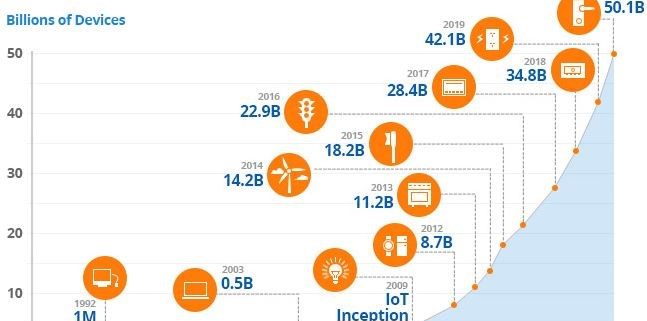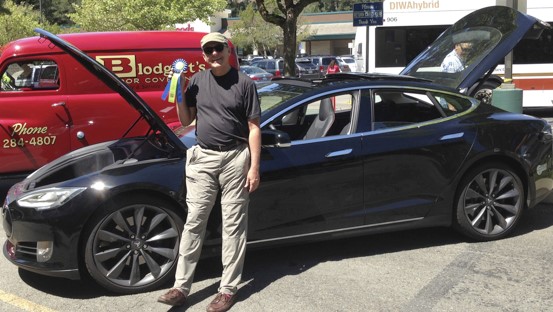Mad Hedge Technology Letter
May 29, 2018
Fiat Lux
Featured Trade:
(HERE ARE SOME EARLY 5G WIRELESS PLAYS),
(T), (VZ), (INTC), (MSFT), (QCOM), (MU), (LRCX), (CVX), (AMD), (NVDA), (AMAT)
How would you like to be part of the biggest business development in the history of mankind?
This revolution will increase business functionality up to 10 times while flattening costs by up to 90%.
Still interested?
Enter the Internet of Things (IoT).
The Internet of Things (IoT) can be boiled down to Internet connectivity with things.
Your luxury juice maker, hair removal kit, and multi-colored Post-its will soon be online.
No, you won't be able to have Tinder chats with the new connectivity, but embedded sensors, tracking technology, and data mining software will aggregate a digital dossier on how products are performing.
The data will be fed back to the manufacturing company offering a comprehensive and accurate review without ever asking a human.
The magic glue making IoT ubiquitous and stickier than a hornet's nest is the emergence and application of 5G.
4G is simply not fast enough to facilitate the astronomical surge in data these devices must process.
5G is the lubricant that makes IoT products a reality.
Verizon Communications (VZ) and AT&T (T) have been assiduously rolling out tests to select American cities as they lay the groundwork for the 5G revolution.
The aim is for these companies to deliver customers a velocious 1 Gbps (gigabits per second) wireless connection speed.
Delivering more than 10 times the average speed today will be a game changer.
America isn't the only one with skin in the game and some would say we are not even leading the pack.
China Mobile (CHL) is carrying out a bigger test in select Chinese cities, and Chinese telecom company Huawei can lay claim to 10% of the 5G patents.
Americans should start to notice broad-based adoption of 5G networks around 2020.
Once widespread usage materializes, watch out!
It will go down in history books as a transformational headline.
The IoT revolution will follow right after.
Until the 5G rollout is done and dusted, tech companies are licking their chops and preparing for one of the biggest shifts in the tech ecosphere affecting every product, service, and industry.
The worldwide IoT market is poised to mushroom into a $934 billion market by 2025 on the back of cloud computing, big data, autonomous transport technology, and a host of other rapidly emerging technology.
The arrival of 5G will have an astronomical network effect. Companies will be able to enhance product specs faster than before because of the feedback of data accumulated by the tracking technology and sensors.
The appearance of this flashy new technology will spawn yet another immeasurable migration to technological devices by 2020.
In just two years, the world will play host to more than 50 billion connected devices all pumping out data as well as consuming data.
What a frightful thought!
IoT's synergies with new 5G technology will have an unassailable influence on the business environment.
For instance, industrial products in the form of robots and equipment will be a huge winner with 5G and IoT technology.
The industrial IoT market is expected to sprout to $233 billion by 2023.
Robots will pervade deeply into economic provenance acting as the mule for brute strength heavy labor plus more advanced tasks as they become more sophisticated.
Total global spending related to IoT products will surpass 1.4 trillion dollars by 2021, according to the International Data Corporation (IDC).
IoT growth will become most robust in the thriving Asian markets fueled by a bonus tailwind of the fastest growing region in the world.
The advanced automation abilities of Germany and the U.K. will also give them a seat at the table.
Micron CEO Sanjay Mehrotra gushed about the future at Micron's investor day celebrating IoT and data as the way forward. Mehrotra explained that the explosion of IoT products will create a new tidal wave of "growing demand for storage and memory."
Chips are a great investment to grab exposure to the 5G, IoT, and big data movement.
Up until today, the last generation of technological innovation brought consumers computers and smartphones.
That world has moved on.
Open up your eyes and you will notice that literally everything will become a "data center on wheels or on feet."
To arrive at this stage, products will need chips.
As many high-grade chips as they can find.
Data centers are one segment in dire need of chips. This market will more than double from $29 billion in 2017 to $62 billion in 2021.
The general-purpose chip market for servers is cornered by Intel.
Industry insiders estimate Intel's market share at 98% to 99% of data center chips. Clientele are heavy hitters such as Amazon Web Services, Google, and Microsoft Azure along with other industry peers.
The only other players with data server chips out there are Qualcomm (QCOM) and Advanced Micro Devices Inc. (AMD).
However, there have been whispers of Qualcomm shutting down the 48-core Centriq 2400 chip for data centers that was launched only last November after head of Qualcomm's data center division, Anand Chandrasekher, was demoted via reassignment.
AMD's new data center chip, Epyc, has already claimed a few scalps with Baidu (BIDU) and Microsoft Azure promising to deploy the new design.
IoT integration is the path the world will take to adopting full-scale digitization.
Microsoft just announced at its own Build 2018 conference its plans to invest $5 billion into IoT in the next four years.
The Redmond, Washington-based company noted operational savings and productivity gains as two positive momentum drivers that will benefit IoT production.
Consulting firm A.T. Kearny identified IoT as the catalyst fueling a $1.9 trillion in productivity increases while shaving $177 billion off of expenses by 2020.
These cloud platforms give tech companies the optimal stage to win over the hearts and dollars of non-tech and tech companies that want to digitize services.
Many of these companies will have IoT products percolating in their portfolio.
Examples are rampant.
Schneider Electric in collaboration with Microsoft's IoT Azure platform brought solar energy to Nigeria by the bucket full.
The company successfully installed solar panels harnessing its performance using IoT technology through the Microsoft cloud.
Kohler rolled out a new lineup of smart kitchen appliances and bathroom fixtures coined "Kohler Konnect" with the help of Microsoft's Azure IoT platform.
Consumers will be able to remotely fill up the bathtub to a personalized temperature.
Real-time data analytics will be available to the consumer by using the bathroom mirror as a visual interface with touch screen functionality giving users the option to adjust settings to optimal levels on the fly.
Kohler's tie-up with Microsoft IoT technology has proved fruitful with product development time slashed in half.
To watch a video of Kohler's new budding relationship with Microsoft's Azure IoT platform, please click here.
It is safe to say operations will cut out the wastefulness using these new tools.
Look no further than legacy American stocks such as oil and gas producer Chevron (CVX), which wants a piece of the IoT pie.
Chevron announced a lengthy seven-year partnership with Microsoft's Azure platform.
The fiber optic cables inside oil production facilities generate more than 1 terabyte of data per day.
In the Houston, Texas, offices, sensors installed six miles below the surface shoot back data to engineers who monitor human safety and system operations on four continents from the Lone Star State.
The newest facility in Kazakhstan, using state-of-the-art technology, will produce more data than all the refineries in North America combined.
Using the aid of artificial intelligence (A.I.), computers will analyze seismic surveys. This pre-emptive technology customizes solutions before problems can germinate.
The new smart-work environment will multiply worker productivity that has been at best stagnant for the past generation.
To get in on the IoT action, buy shares of companies with solid IoT cloud platforms such as Microsoft and Amazon.
Buy best-of-breed chip companies such as Nvidia (NVDA), Intel (INTC), Advanced Micro Devices (AMD) and Micron (MU).
And buy tech companies that produce wafer fab equipment such as Applied Materials (AMAT) and Lam Research (LRCX).
_________________________________________________________________________________________________
Quote of the Day
"Don't be afraid to change the model." - said cofounder and CEO of Netflix Reed Hastings.
Mad Hedge Technology Letter
May 25, 2018
Fiat Lux
Featured Trade:
(WHERE 5G CONNECTIVITY WILL TAKE US),
(T), (VZ), (INTC), (TSLA), (AAPL), (GOOGL)
AT&T (T), Verizon (VZ), and the other telecom heavies are in the process of investing $30 billion to make sure that fifth-generation wireless, or 5G, will roll out on time in 2020.
What 5G will do is improve the functionality of IoT (Internet of Things) by 10 times at one-tenth the cost, bringing a 100X increase of functionality over price.
The last time I saw a leap that great was when Intel (INTC) brought out its groundbreaking 8008 8-bit microprocessor chip in 1972. I remember it like it was yesterday.
The news that gravitational waves were discovered, as well as wrinkles in the space-time continuum, was big news in my family. 5G will be of that order.
Of course, we knew it was coming. It was just a matter of when.
I have 11- and 13-year-old girls (I can't help it if the plumbing still works!). Whenever we drive somewhere, we carry out what Einstein called "thought experiments."
They will come up with scientific questions, and I then direct them into finding their own answers through a series of prodding and hopeful questions.
It is much like how the children of royalty were tutored during the Middle Ages.
So they asked, "When will we get driverless cars?" which they had heard about on TV.
I answered in about two years, but that I had friends who run Tesla (TSLA) who already have them now.
And you know the interesting thing they discovered? After two years of beta testing, the cars are starting to develop their own personalities.
Each car has highly advanced learning software. When the mapping software requires one to take a difficult sharp left turn, the vehicle may miss it the first time.
It will then make the next legal U-turn, and then nail that turn every time in the future.
The cars are all programmed to drive like little old ladies. It will never speed, break the law, and always lets other cars cut in front. Over time, some are becoming cautious, while others are getting more aggressive depending on each individual's driving experience.
In other words, experience is turning them into "people."
I asked my daughters, "What would the world be like if everyone had driverless cars?" which will occur in about 30 years, or during their middle age.
They pondered for a moment. Then my older daughter shouted out, "There won't be car accidents anymore!" "Right!" I answered.
"But what will that mean?" I asked.
They puzzled over this.
A few seconds passed. Then it came. "The people who fix cars won't have anything to do!"
"You got it," I replied.
In fact, about 1 million people in the car repair industry will lose their jobs. A small group of vintage car fanatics will survive, much like horse and buggy hobbyists do today.
I pointed out that this is already happening because electric cars don't require any maintenance. You just rotate the tires every 6,000 miles (because electric batteries are so heavy).
I moved on. "Who else will lose their jobs when cars become self-driving?" They hit a brick wall. Then I asked "What else breaks when cars have accidents?"
A few seconds later it came. "People!"
"For sure," I shot back.
Actually, about 35,000 people die in car accidents every year in the United States, and another 500,000 are injured.
This means the demand for doctors, hospitals, and ambulances will go down. Say goodbye to another 1 million jobs.
"So, what else will self-driving cars do?" I was relentless.
My older girl was first: "If cars are driven by computers, it means they can drive closer together." I said, "That was true, but what was the consequence of that?"
The mountain scenery whizzed by. Then they got it.
"There won't be traffic jams anymore."
"Yes!" I blurted out. If a car can drive 70 miles per hour, but only needs to remain one car length behind the one in front of it, that effectively increases the capacity of freeways seven times.
We will never need to build another freeway again. Another 1 million jobs go down the drain.
"What else will self-driving cars do?" I carried on.
They hit a dead end. So, I gave a hint. "What do you see in cities?" After going through buildings, parks, roads, lots of cars, and bridges, I finally got the answer I wanted: "Parking lots."
I then posed the conundrum, "What's the connection between self-driving cars and parking lots?"
Now they were getting into the spirit of the thing. "They won't need them." I replied, "Absolutely."
Self-driving cars won't need to park. They'll just be able to drop you off and drive around the block until you are ready to go home.
This will be economical because after three decades of battery and solar improvements, energy will effectively be free, like air is today.
Oh, and at least 100,000 parking attendants might as well start joining the unemployment lines now.
It gets better.
Entrepreneurs now are developing apps for cars so they never need to park.
In an iteration of the sharing economy, and in a club or membership type format, your car will just drive person to person, selling rides, until you are ready to go home.
Think of it as Uber, without the drivers, that pays you.
Today, parking lots occupy about 15% of the land area of large cities. Self-driving cars will free up a lot of that space for other uses, such as housing and parks.
Then I asked the really big question. "What do all of these changes have in common?"
My 11-year-old picked up on this immediately. "A lot of people are going to lose their jobs!"
"For sure," I bubbled. Notice that every new technology improvement creates a lot of job losses. I went on.
"The trick for you girls is to always stay ahead of the technology curve so your job doesn't get lost, too." This is why I have been sending them to Java development school since they were 8 and 9.
They looked daunted.
And this is what 11- and 13-year-olds were able to figure out. Granted, they were MY kids.
Imagine what Google (GOOGL), Apple (AAPL), and Tesla are doing with this idea. It has become a hot bottom "next big thing." Silicon Valley is now rife with rumors of breakthrough developments and the poaching of staff.
The U.S. military and the Defense Advanced Research Projects Agency (DARPA) are involved in self-driving vehicles in a big way as well, holding regular contests with big prize money and the prospect of mammoth government contracts.
More and more generals and admirals are telling me that the wars of the future will be fought with software.
The bottom line is that things are happening much faster than we imagined possible only a few years ago.
Then my oldest daughter piped up.
"Dad, can I get my driver's license before all the cars are self-driving?" I said, "Sure. What kind of car do you want?"
"A red one."
My first car was a red 1957 Volkswagen Beetle.
On our next trip we will cover gravitational waves, Einstein's Theory of Relativity, and the significance of the clock tower in Bern, Switzerland.
By the way, these girls will be graduating from college in 2026 and 2027 and will be looking for jobs.
Just let me know. :-)
_________________________________________________________________________________________________
Quote of the Day
"Homo sapiens, the first truly free species, is about to decommission the natural selection, the force that made us," said E.O. Wilson, a Harvard University biology professor.
Mad Hedge Technology Letter
May 24, 2018
Fiat Lux
Featured Trade:
(MICRON'S BLOCKBUSTER SHARE BUYBACK)
(MU), (AMZN), (NFLX), (AAPL), (SWKS), (QRVO), (CRUS), (NVDA), (AMD)
The Amazon (AMZN) and Netflix (NFLX) model is not the only technology business model out there.
Micron (MU) has amply proved that.
Bulls were dancing in the streets when Micron announced a blockbuster share buyback of $10 billion starting in September.
This is all from a company that lost $276 million in 2016.
The buyback is an overwhelmingly bullish premonition for the chip sector that should be the lynchpin to any serious portfolio.
The news keeps getting better.
Micron struck a deal with Intel to produce chips used in flash drives and cameras. Every additional contract is a feather in its cap.
The share repurchase adds up to about 16% of its market value and meshes nicely with its choreographed road map to return 50% of free cash flow to shareholders.
Tech's weighting in the S&P has increased 3X in the past 10 years.
To put tech's strength into perspective, I will roll off a few numbers for you.
The whole American technology sector is worth $7.3 trillion, and emerging markets and European stocks are worth $5 trillion each.
Tech is not going away anytime soon and will command a higher percentage of the S&P moving forward and a higher multiple.
The $5 billion in profit Micron earned in 2017 was just the start and sequential earnings beats are part of their secret sauce and a big reason why this name has been one of the cornerstones of the Mad Hedge Technology Letter portfolio since its inception as well as the first recommendation at $41 on February 1.
Did I mention the stock is dirt cheap at a forward PE multiple of just 6 and that is after a 35% rise in the share price so far this year?
What's more, putting ZTE back into business is a de-facto green light for chip companies to continue sales to Chinese tech companies.
China consumed 38% of semiconductor chips in 2017 and is building 19 new semiconductor fabrication plants (FAB) in an attempt to become self-sufficient.
This is part of its 2025 plan to jack up chip production from less than 20% of global share in 2015 to 70% in 2025.
This is unlikely to happen.
If it was up to them, China would dump cheap chips to every corner of the globe, but the problem is the lack of innovation.
This is hugely bullish for Micron, which extracts half of its revenue from China. It is on cruise control as long as China's nascent chip industry trails miles behind them.
At Micron's investor day, CFO David Zinsner elaborated that the mammoth buyback was because the stock price is "attractive" now and further appreciation is imminent.
Apparently, management was in two camps on the capital allocation program.
The two choices were offering shareholders a dividend or buying back shares.
Management chose share repurchases but continued to say dividends will be "phased in."
This is a company that is not short on cash.
The free cash flow generation capabilities will result in a meaningful dividend sooner than later for Micron, which is executing at optimal levels while its end markets are extrapolating by the day.
As it stands today, Micron is in the midst of taking its 2017 total revenue of about $20 billion and turning it into a $30 billion business by the end of 2018.
Growth - Check. Accelerating Revenue - Check. Margins - Check. Earnings beat - Check. Guidance hike - Check.
The overall chips market is as healthy as ever and data from IDC shows total revenues should grow 7.7% in 2018 after a torrid 2017, which saw a 24% bump in revenues.
The road map for 2019 is murkier with signs of a slowdown because of the nature of semi-conductor production cycles. However, these marginal prognostications have proved to be red herrings time and time again.
Each red herring has offered a glorious buying opportunity and there will be more to come.
Consolidation has been rampant in the chip industry and shows no signs of abating.
Almost two-thirds of total chip revenue comes from the largest 10 chip companies.
This trend has been inching up from 2015 when the top 10 comprised 53% in 2016 and 56% in 2017.
If your gut can't tell you what to buy, go with the bigger chip company with a diversified revenue stream.
The smaller players simply do not have the cash to splurge on cutting-edge R&D to keep up with the jump in innovation.
The leading innovator in the tech space is Nvidia, which has traded back up to the $250 resistance level and has fierce support at $200.
Nvidia is head and shoulders the most innovative chip company in the world.
The innovation is occurring amid a big push into autonomous vehicle technology.
Some of the new generation products from Nvidia have been worked on diligently for the past 10 years, and billions and billions of dollars have been thrown at it.
Chips used for this technology are forecasted to grow 9.6% per year from 2017-2022.
Another death knell for the legacy computer industry sees chips for computers declining 4% during 2017-2022, which is why investors need to avoid legacy companies like the plague, such as IBM and Oracle because the secular declines will result in nasty headlines down the road.
Half way into 2018, and there is still a dire shortage of DRAM chips.
Micron's DRAM segments make up 71% of its total revenue, and the 76% YOY increase in sales underscores the relentless fascination for DRAM chips.
Another superstar, Advanced Micro Devices (AMD), has been drinking the innovation Kool-Aid with Nvidia (NVDA).
Reviews of its next-generation Epyc and Ryzen technology have been positive; the Epyc processors have been found to outperform Intel's chips.
The enhanced products on offer at AMD are some of the reasons revenue is growing 40% per year.
AMD and Nvidia have happily cornered the GPU market and are led by two game-changing CEOs.
It is smart for investors to focus on the highest quality chip names with the best innovation because this setup is most conducive to winning the most lucrative chip contracts.
Smaller players are more reliant on just a few contracts. Therefore, the threat of losing half of revenue on one announcement exposes smaller chip companies to brutal sell-offs.
The smaller chip companies that supply chips to Apple (AAPL) accept this as a time-honored tradition.
Avoid these companies whose share prices suffer most from poor analyst downgrades of the end product.
Cirrus Logic (CRUS), Skyworks Solutions (SWKS), and Qorvo Inc. (QRVO) are small cap chip companies entirely reliant on Apple come hell or high water.
Let the next guy buy them.
Stick with the tried and tested likes of Nvidia, AMD, and Micron because John Thomas told you so.
_________________________________________________________________________________________________
Quote of the Day
"Bitcoin will do to banks what email did to the postal industry." - said Swedish IT entrepreneur and founder of the Swedish Pirate Party Rick Falkvinge.
Mad Hedge Technology Letter
May 23, 2018
Fiat Lux
Featured Trade:
(WHY THE BIG DEAL OVER ZTE?),
(MU), (QCOM), (INTC), (AAPL), (SWKS), (TXN), (BIDU), (BABA)
Here's the conundrum.
Beyond cutting-edge technology, there's nothing that China WANTS OR NEEDS to buy from the U.S. China's largest imports are in energy and foodstuffs, both globally traded commodities.
China is playing the long game because it can.
Earlier this year, China altered its constitution to remove term limits and any obstacle that would hinder Chairman Xi to serve indefinitely.
If it's two, four, eight or 10 years, no problem, China will wait it out.
As it stands, China is enjoying the status quo, which is a robust economic trajectory of 6.7% economic growth YOY and at that rate will leapfrog America as the biggest economy in the world by 2030.
China does not need handouts.
It already has its mooncake and is eating it.
The Chinese are also betting that Donald Trump fades away with the passage of time, possibly soon, and that a vastly different administration will enter the fray with an entirely different strategy.
The indefinite "hold" pattern is a polite way to say we surrender.
ZTE Corporation is a Chinese telecommunications equipment manufacturer and low-end smartphone maker based in Shenzhen, China.
This seemingly innocuous company is ground zero for the U.S. vs China trade practice dispute.
The U.S. Department of Commerce banned American tech companies from selling components to ZTE for seven years, crippling its supply chain after violating sanctions against Iran and North Korea.
ZTE uses about 30% of American components to produce its smorgasbord of telecom equipment and down-market cell phones.
What most people do not know is that ZTE is the fourth most prevalent smartphone in America, only behind Apple, Samsung, and LG, commanding a 12.2% market share, and its phones require an array of American made silicon parts.
In 2017, the company shipped more than 20 million phones to the United States.
The ruling effectively put ZTE out of business because the lack of components shelved production.
Low-end smartphones account for almost one-third of total revenue.
ZTE could very well have survived with a direct hit to its consumer phone business, but the decision to ban components made the telecom equipment division inoperable.
This segment accounts for a heavy 58.2% of revenue. Therefore, disrupting ZTE's supply chain would effectively take down more than 91% of its business for a company that employs 75,000 employees in over 160 countries.
Upon news of ZTE's imminent demise, the administration made a U-turn on its initial decision stating "too many jobs in China lost."
The reversal made America look bad.
It shows that America is being dictated to and not the other way around.
When did it become the responsibility of the American administration to fill Chinese jobs for a company that is a threat to national security?
The Chinese refused to continue talks with the visiting delegation until the ZTE situation was addressed.
Treasury Secretary Steve Mnuchin and company were able to "continue" the talks then were politely shown the door.
Bending the rules for ZTE should have never been a prerequisite for talks, stressing the lack of firepower in the administration's holster.
However, stranding the delegation in Chinese hotel rooms for days waiting in limbo, without offering an audience, would have caused even more humiliation and anguish for the administration.
China is not interested in buying much from America, but one thing it needs -- and needs in droves -- are chips.
Long term, this ZTE ban is great for China.
I believe China will use this episode to rile up the nationalistic rhetoric and make it a point to wean itself from American chips.
However, for the time being, American chips are the most valuable import America can offer China, and that won't change for the foreseeable future.
The numbers back me up.
Micron (MU) earns more than $10 billion in revenue from China, which makes up over 51% of its total revenue.
Qualcomm (QCOM), mainly through its lucrative licensing division, makes more than $14.5 billion from its Chinese revenue, which comprises over 65% of revenue.
Texas Instruments (TXN) earns more than 44% of revenue from China, and almost a quarter of Intel's (INTC) revenue is derived from its China operations.
The biggest name embedded in China is Apple (AAPL), which earned almost $45 billion in sales last year. Its China revenue is three times larger than any other American company.
In less than a decade, China has caught up.
China now has adequate local smartphone substitutes through Huawei, Oppo, Vivo, and Xiaomi phones.
Skyworks Solutions (SWKS), a chip company reliant on iPhone contracts, is most levered toward the Chinese market capturing almost 83% of revenue from China.
You would think these chips would be the first on the chopping block in a trade war. However, you are wrong.
China needs all the chips it can get because there is no alternative.
Stopping the inflow of chips is another way of stopping China from doing business and developing technology.
The Chinese economy has been led by the powerful BATs of Baidu (BIDU), Tencent, and Alibaba (BABA) occupying the same prominent role the American FANGs hold in the American economy.
They are not interested in digging their own grave.
To execute the 2025 plan to become the world leaders in advanced technology, they need chips that power all modern electronic devices.
The most likely scenario is that China maintains development using American chips for the time being and slowly pivots to the Korean chip sector, which is vulnerable to Chinese political pressure.
Remember that South Koreans have two of the three biggest chip companies in the world in Samsung and SK Hynix. China has used economic coercion to get what it wants from Korea in the past or to prove a point.
Korean multinational companies, shortly after the Terminal High Altitude Area Defense (THAAD) installation on the Korean peninsula, were penalized by the Chinese government shutting down mainland Korean stores, temporarily banning Chinese tourism in South Korea, and blocking K-pop stars from performing in the lucrative Chinese market.
The Chinese communist government can turn the screws when it wants and how it wants.
Therefore, the next battleground for tech could migrate to South Korean chip companies as China is on a mission to suck up as much high-grade tech ingenuity as possible while it can.
China has some easy targets to whack down if the administration forces it into a corner with a knife to its throat.
Non-tech companies are ripe for massacre because they do not produce chips.
Companies such as Procter & Gamble, Starbucks, McDonald's, and Nike could be replaced by a Chinese imitation in a jiffy.
Apple is the 800-pound gorilla in the room.
An attack on Apple would hyper-accelerate tension between two leaders to the highest it's ever been and would be the straw that breaks the camel's back.
Technology has transformed the world.
Technology also has been adopted by nations as a critical component to national security.
Nothing has changed fundamentally, and nothing will.
China will become the biggest economy in the world by 2030.
China will kick the proverbial can down the road because it can. It never has to cooperate with America again.
Contrary to expectations, American chip companies are untouchable, and investors won't see Micron suddenly losing half its revenue over this trade war.
Until China can produce higher quality chips, it will lap up as much of Uncle Sam's chips until it can force transfer the chip technology from the Koreans.
American chip companies can breathe a sigh of relief.
_________________________________________________________________________________________________
Quote of the Day
"If we go to work at 8 a.m. and go home at 5 p.m., this is not a high-tech company and Alibaba will never be successful. If we have that kind of 8-to-5 spirit, then we should just go and do something else." - said Alibaba founder and executive chairman Jack Ma.
Mad Hedge Technology Letter
May 22, 2018
Fiat Lux
Featured Trade:
(THE BIG WINNERS IN THE SPORTS BETTING DECISION),
(LSE:PPB), (LSE:WMH), (LSE:888), (BYD), (IGT), (SGMS)
Up to my elbows in the market for the past 50 years, I have seen my share of paradigm shifts transforming the world and markets with it.
The Supreme Court delivered another momentous decision overturning the 1992 decision to ban sports betting in most states.
The aftermath is decisively pro-business with a profusion of domestic and international winners that can bask in the glow of a future windfall swelling the industry coffers to the tune of $150 billion per year.
The estimated amount of illicit sports gambling activity that goes unreported is $150 billion, and that will migrate to official channels, but I bet the sum is vastly higher.
Sports betting is as American as apple pie.
This is highly evident each year with the NCAA men's basketball tournament sucking in eyeballs resulting in more than $5 billion in lost worker productivity.
The annual Super Bowl is practically an institution in this country as well as quarterback Tom Brady's starting spot on Super Bowl Sunday.
Not only is this ruling pro-business, but the verdict is another overwhelming win for technology and the state of Nevada.
Nevada was one of the few states to receive an exemption from the 1992 ruling, and its sports betting books have developed uninterrupted for the past 26 years.
The 26-year head start will mirror Amazon's seven-year head start in the cloud catapulting existing operations to the top of the food chain.
Sports team owners from all the major sports leagues are jumping with joy as the team valuations of each franchise received another boost with fresh capital pouring in like an overflowing dam.
This development effectively creates a digital sports industry operating parallel to the official leagues and will have business synergies galore.
Sports leagues are about to welcome a new tidal wave of viewer interest that seeks to capitalize on the new synergies.
Options derivative contracts on sports games could be another product down the road for this budding industry.
The two best tech companies in position to take the court ruling and turn it into material business are the leading fantasy sports providers DraftKings and FanDuel, which are both private companies.
In 2016, these two companies attempted a merger that would have given the company a 90% monopolistic market share and more than 5 million customers.
The following year, the Supreme Court blocked the merger as DraftKings continued to grow in excess of 8 million users.
Fantasy sports and the entire e-sports genre is experiencing skyrocketing popularity with youth (physical) sports participation falling off a cliff.
New York-based FanDuel and Boston-based DraftKings have a wide-reaching digital footprint in fantasy sports that is supported by rich tech architecture.
The abundance of tech capabilities will make the crossover into sport wagering seamless.
NumberFire, a sports big data company, was bought up by FanDuel in 2015, and has close to 1 million subscribers parsing through its analytics.
The sports big data movement was christened by Bill James who coined the study of statistics in baseball as sabermetrics. That was the platform used by the Oakland Athletics' General Manager Billy Beane that later developed into a movie and book called Moneyball written by Michael Lewis starring Brad Pitt.
FanDuel was able to poach an entire team of sports tech developers when Zynga 365 Sports went bust after a few sports titles failed to stick and FanDuel picked up 38 of the 42 leftover developers in 2015.
DraftKings has pounced its increasing headcount from 425 to 700 at its Boston headquarters taking advantage of the new legislation to ramp up the required staff.
Plundering talent across the pond, too, leaving no stone unturned is a statement of intent.
DraftKings anointed Sean Hurley, who cut his teeth as head of U.K. B2B sports betting technology supplier Amelco and niche online sports book Whale Global, as its new head of sportsbook.
Tapping the U.K. for sports tech talent makes sense.
The U.K. legalized sports betting in 1961. The Brits bet more than $20 billion last year.
There is an affluence of sports betting tech know-how for hire in Europe. American companies would be naive not to pursue staff reinforcements at a time when companies are fortifying talent levels.
Thus, opening up an extensive market full of sports-crazed fans gives U.K. firms a tasty new opportunity to pursue with existing foundations in place.
Upon the announcement, online sports book outfit 888 Holdings (LSE:888) exploded 15% on the London Stock Exchange.
It's subsidiary 888sport was the first foreign company to receive a license to operate by the Nevada Gaming Commission in 2013.
Paddy Power Betfair (LSE:PPB), based in Dublin, is another company poised to benefit and has launched a takeover bid for FanDuel to seize further gains in market share.
Discussions are ongoing.
This all comes after buying U.S. headquartered Draft, a fantasy sports rival, for $48 million.
There are obvious synergies between fantasy sports and sports betting as they both process ample amounts of data that help set the odds for each game.
Online sports betting is another industry that is waiting for Artificial Intelligence (A.I.) to enhance the betting products, creating a plethora of new business opportunities.
British firms use the same in-game add-on product strategy that is popular with e-gaming franchises such as Fortnite.
In-game bets allow gamblers to wager on specific events within a game such as the first scorer of a soccer match or the first player to receive a yellow card.
Niche betting has proved hugely popular.
Paddy Power has already made inroads in America with a horseracing and greyhound racing TV channel and sportsbook called TVG and an online casino in the state of New Jersey.
Cross-border talent poaching will heat up as premium dollars are up for grabs favoring the first movers that can retain business.
The last clear-cut U.K. winner is William Hill (LSE:WMH), which already has an outsized presence in America by way of its purchase of three Nevadan sports books: Lucky, Leroy's, and Club Cal Neva, for a grand total of $53 million.
The deal gave William Hill an 11% market share of sports book revenues in Nevada. The British bookmaker's sports book can be seen dotted all over Las Vegas and Reno thoroughfares.
CEO of William Hill, Philip Bowcock chimed in saying America will benefit with an injection of "100,000 new jobs" stateside, and consumer safety will increase with the need to bet under the table swept into the dustbin of history.
The U.S.-based fantasy sports powerhouses, U.K.-based sports betting sites, and the State of Nevada are the unwavering victors.
The last stratum of indirect winners are the companies that manufacture sports betting equipment.
No doubt that states will likely set up brick-and-mortar sports betting establishments. Companies such as Boyd Gaming (BYD), Scientific Games Corporation (SGMS), and International Game Technology (IGT) could see a nice revenue bump stemming from the equipment they manufacture.
_________________________________________________________________________________________________
Quote of the Day
"Cybersecurity is not only a question of developing defensive technologies but offensive technologies, as well," said President of the United States Donald J. Trump.
Legal Disclaimer
There is a very high degree of risk involved in trading. Past results are not indicative of future returns. MadHedgeFundTrader.com and all individuals affiliated with this site assume no responsibilities for your trading and investment results. The indicators, strategies, columns, articles and all other features are for educational purposes only and should not be construed as investment advice. Information for futures trading observations are obtained from sources believed to be reliable, but we do not warrant its completeness or accuracy, or warrant any results from the use of the information. Your use of the trading observations is entirely at your own risk and it is your sole responsibility to evaluate the accuracy, completeness and usefulness of the information. You must assess the risk of any trade with your broker and make your own independent decisions regarding any securities mentioned herein. Affiliates of MadHedgeFundTrader.com may have a position or effect transactions in the securities described herein (or options thereon) and/or otherwise employ trading strategies that may be consistent or inconsistent with the provided strategies.



























